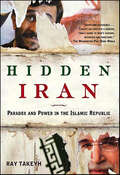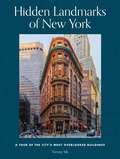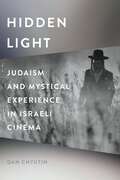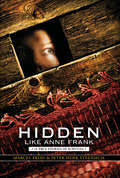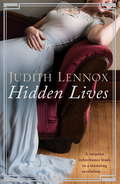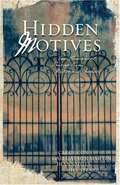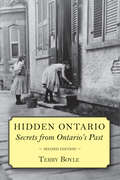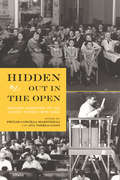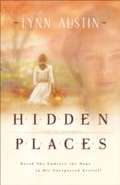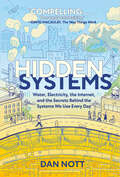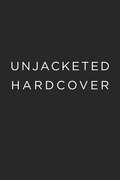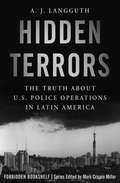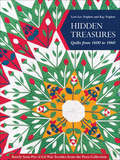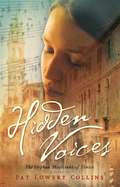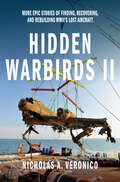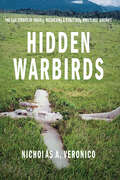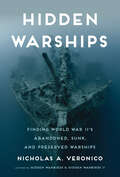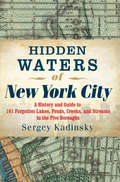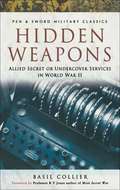- Table View
- List View
Hidden Horrors
by Yuki TanakaThis book documents for the first time previously hidden Japanese atrocities in World War II, including cannibalism; the slaughter and starvation of prisoners of war; the rape, enforced prostitution, and murder of noncombatants; and biological warfare experiments.The author describes how desperate Japanese soldiers consumed the flesh of their own comrades killed in fighting as well as that of Australians, Pakistanis, and Indians. Another chapter traces the fate of 65 shipwrecked Australian nurses and British soldiers who were shot or stabbed to death by Japanese soldiers. Thirty-two other nurses, who landed on another island, were captured and sent to Sumatra to become "comfort women"-prostitutes for Japanese soldiers. Tanaka recounts how thousands of Australian and British POWs died in the infamous Sandakan camp in the Borneo jungle in 1945. Those who survived were forced to endure a tortuous 160-mile march on which anyone who dropped out of line was immediately shot. Only six escapees lived to tell the tale.Based on exhaustive research in previously closed archives, this book represents a landmark analysis of Japanese war crimes. The author explores individual atrocities in their broader social, psychological, and institutional milieu and places Japanese behavior during the war in the broader context of the dehumanization of men at war-without denying individual and national responsibility.
Hidden Horrors
by Yuki TanakaThis book documents for the first time previously hidden Japanese atrocities in World War II, including cannibalism; the slaughter and starvation of prisoners of war; the rape, enforced prostitution, and murder of noncombatants; and biological warfare experiments.The author describes how desperate Japanese soldiers consumed the flesh of their own comrades killed in fighting as well as that of Australians, Pakistanis, and Indians. Another chapter traces the fate of 65 shipwrecked Australian nurses and British soldiers who were shot or stabbed to death by Japanese soldiers. Thirty-two other nurses, who landed on another island, were captured and sent to Sumatra to become "comfort women"-prostitutes for Japanese soldiers. Tanaka recounts how thousands of Australian and British POWs died in the infamous Sandakan camp in the Borneo jungle in 1945. Those who survived were forced to endure a tortuous 160-mile march on which anyone who dropped out of line was immediately shot. Only six escapees lived to tell the tale.Based on exhaustive research in previously closed archives, this book represents a landmark analysis of Japanese war crimes. The author explores individual atrocities in their broader social, psychological, and institutional milieu and places Japanese behavior during the war in the broader context of the dehumanization of men at war-without denying individual and national responsibility.
Hidden Horrors
by Yuki TanakaThis book documents for the first time previously hidden Japanese atrocities in World War II, including cannibalism; the slaughter and starvation of prisoners of war; the rape, enforced prostitution, and murder of noncombatants; and biological warfare experiments. The author describes how desperate Japanese soldiers consumed the flesh of their own comrades killed in fighting as well as that of Australians, Pakistanis, and Indians. Another chapter traces the fate of 65 shipwrecked Australian nurses and British soldiers who were shot or stabbed to death by Japanese soldiers. Thirty-two other nurses, who landed on another island, were captured and sent to Sumatra to become "comfort women”--prostitutes for Japanese soldiers. Tanaka recounts how thousands of Australian and British POWs died in the infamous Sandakan camp in the Borneo jungle in 1945. Those who survived were forced to endure a tortuous 160-mile march on which anyone who dropped out of line was immediately shot. Only six escapees lived to tell the tale. Based on exhaustive research in previously closed archives, this book represents a landmark analysis of Japanese war crimes. The author explores individual atrocities in their broader social, psychological, and institutional milieu and places Japanese behavior during the war in the broader context of the dehumanization of men at war--without denying individual and national responsibility.
Hidden Iran: Paradox and Power in the Islamic Republic
by Ray TakeyhA leading expert explains why we fail to understand Iran and offers a new strategy for redefining this crucial relationshipFor more than a quarter of a century, few countries have been as resistant to American influence or understanding as Iran. The United States and Iran have long eyed each other with suspicion, all too eager to jump to conclusions and slam the door. What gets lost along the way is a sense of what is actually happening inside Iran and why it matters. With a new hard-line Iranian president making incendiary pronouncements and pressing for nuclear developments, the consequences of not understanding Iran have never been higher.Ray Takeyh, a leading expert on Iran's politics and history, has written a groundbreaking book that demystifies the Iranian regime and shows how the fault lines of Iran's domestic politics serve to explain its behavior. In Hidden Iran, he explains why this country has so often confounded American expectations and why its outward hostility does not necessarily preclude the normalization of relations. Through a clearer understanding of the competing claims of Muslim theology, republican pragmatism, and factional competition, he offers a new paradigm for managing our relations with this rising power.
Hidden Landmarks of New York: A Tour of the City's Most Overlooked Buildings
by Tommy SilkDiscover dozens of underappreciated landmarks and the stories behind them in this unique history on New York City, written and photographed by Landmarks of NY creator, Tommy Silk. New York is a city of landmarks – more than 37,000 of them. Visitors and New Yorkers walk by hundreds of these landmarks daily, often never knowing the rich history behind each of these buildings. One of these New Yorkers, Tommy Silk, has been photographing and chronicling a landmarked building every day for the last five years on his Instagram account, Landmarks of NY. In Hidden Landmarks of New York, Silk uncovers 120 of the city&’s oldest, most unique, and often relatively unknown landmarks and the hidden history behind them. Whether it&’s an African Graveyard a stone&’s throw from City Hall; the Truman Capote house in Brooklyn Heights that he claimed to own (but actually just rented a room there for years); or 4 Gramercy Park West, the Greek Revival-style townhouse that is rumored to be the home of Stuart Little; each entry includes a picture of the landmark with a short, informative description of its history and its past (often well-known) inhabitants. With 120 photographs beautifully designed in a portable book, it&’s perfect for armchair perusal or to stash in your backpack while wandering around the city.
Hidden Light: Judaism and Mystical Experience in Israeli Cinema (Contemporary Approaches to Film and Media Series)
by Dan ChyutinOver the past several decades, the prevailing attitude toward Judaism in Israeli society has undergone a meaningful shift; where the national ethos had once deemed Judaic traditions a vestige of an arcane past incompatible with the culture of a modern state, there is now greater acceptance of these traditions by a sizeable part of Israeli society. Author Dan Chyutin reveals this trend through a parallel shift toward acceptance and celebration of Judaic identity and lifestyle in modern Israeli cinema. Hidden Light explores the Judaic turn in contemporary Israeli filmmaking for what it can tell us about Israel’s cultural landscape, as well as about the cinematic medium in general. Chyutin points to the ambivalence of films which incorporate Judaism into Israel’s secular ethos; concurrently, he foregrounds the films' attempt to overcome this ambivalence through reference to and activation of experiences of transcendence and unity, made popular by New Age–inflected understandings of Jewish mystical thought. By virtue of this exploration, Judaic-themed Israeli cinema emerges as a crucial example of how film’s particular form of "magic" may be exploited for the purpose of affecting mystical states in the audience.
Hidden Like Anne Frank: 14 True Stories Of Survival
by Marcel Prins Peter Henk SteenhuisFor readers of The Boy Who Dared and Prisoner B-3087, a collection of unforgettable true stories of children hidden away during World War II.Jaap Sitters was only eight years old when his mother cut the yellow stars off his clothes and sent him, alone, on a fifteen-mile walk to hide with relatives. It was a terrifying night, one he would never forget. Before the end of the war, he would hide in secret rooms and behind walls. He would suffer from hunger, sickness, and the looming threat of Nazi raids. But he would live.This is just one of the true stories told in Hidden Like Anne Frank, a collection of eye-opening first-person accounts that share the experience of going into hiding to escape the Holocaust. Some were just toddlers when they were hidden; some were teenagers. Some hid with neighbors or family, while many were with complete strangers. But all know the pain of losing their homes, their families, even their own names. They describe the secret network that kept them safe. And they share the coincidences and close calls that made all the difference.
Hidden Lives
by Judith LennoxHIDDEN LIVES is the latest mesmerising tale of drama and intrigue from Judith Lennox, sure to appeal to readers of Kate Morton and Rachel Hore. Praise for Judith Lennox: 'A beautifully turned, compassionate novel' Daily MailA surprise inheritance reveals the hidden lives of two sisters, torn apart by tragedy...Following her grandmother's death, Rose Martineau inherits The Egg, an extraordinary house nestling in the Sussex countryside. She discovers that the mysterious house originally belonged to her grandmother's younger sister, Sadie, who Rose never knew existed. In her search to uncover why the sisters grew apart, Rose is drawn back into the glamorous and decadent world of the 1930s. Meanwhile, Rose's own life as a dutiful wife and mother is turned upside down by a sordid scandal that threatens to destroy her marriage. It is only once she has unravelled the secrets of Sadie's past that she is able to look to her own future...An epic tale of secrets, scandal, jealousy and passion spanning the twentieth century.
Hidden Lives
by Judith LennoxHIDDEN LIVES is the latest mesmerising tale of drama and intrigue from Judith Lennox, sure to appeal to readers of Kate Morton and Rachel Hore. Praise for Judith Lennox: 'A beautifully turned, compassionate novel' Daily MailA surprise inheritance reveals the hidden lives of two sisters, torn apart by tragedy...Following her grandmother's death, Rose Martineau inherits The Egg, an extraordinary house nestling in the Sussex countryside. She discovers that the mysterious house originally belonged to her grandmother's younger sister, Sadie, who Rose never knew existed. In her search to uncover why the sisters grew apart, Rose is drawn back into the glamorous and decadent world of the 1930s. Meanwhile, Rose's own life as a dutiful wife and mother is turned upside down by a sordid scandal that threatens to destroy her marriage. It is only once she has unravelled the secrets of Sadie's past that she is able to look to her own future...An epic tale of secrets, scandal, jealousy and passion spanning the twentieth century.
Hidden Motives: Four Romances Emerge from Mysterious Shadows
by Diann Mills Carol Cox Jill Stengl Gail G. MartinSuspense, mystery, and danger pervade the four stories of this romance collection. As love blossoms for four women, threatening situations also arise. Laurel's resolve is tested when a cyber stalker begins sending menacing E-mails. Gerri goes undercover as a housekeeper in an attempt to vindicate her wrongfully accused grandfather. Shelby travels to her vacant childhood home in Louisiana to find the key to recurring migraines. Stephanie works to restore an old church only to be warned by mysterious lights to leave things as they are. Should they proceed with their dangerous tasks? Can they trust their hearts to guide them?
Hidden Ontario: Secrets from Ontario’s Past
by Terry BoyleLimited time offer. Terry Boyle unveils the eccentric and bizarre in these mini-histories of Ontario’s towns and cities: the imposter who ran the Rockwood Asylum in Kingston; Ian Fleming’s inspiration for James Bond; the Prince of Wales’s undignified crossing of Rice Lake; the tragic life of Joseph Brant; the man who advertised his wife’s death before poisoning her; as well as Ontario’s first bullfight and the answer to the question, "Why did so many lumberjacks sport beards?" The colourful characters, Native legends, and incredible tales that make up our province’s fascinating past come alive in Hidden Ontario. From Bancroft, Baldoon, and Brighton to Timmins, Toronto, and Trenton, find out more about the Ontario you thought you knew.
Hidden Out in the Open: Spanish Migration to the United States (1875-1930)
by Brian D. Bunk George E. Pozzetta Christopher J. Castañeda Gary R. Mormino Thomas Hidalgo Beverly LozanoHidden Out in the Open is the first English-language volume on Spanish migration to the United States in the late nineteenth and early twentieth centuries. This panoramic study covers a period defined by the crucial transformations of the Progressive Era in the United States, and by similarly momentous changes in Spain following the Restoration of the Bourbon monarchy under Alfonso XII. The chapters in this volume are geographically wide-ranging, reflecting the transnational nature of the Spanish diaspora in the Americas, encompassing networks that connected Spain, Cuba, Latin American countries, the United States, and American-controlled territories in Hawai’i and Panama. The geographic diversity reveals the different jobs immigrants engaged in, from construction gangs in the Panama Canal to mining crews in Arizona and West Virginia. Contributors analyze the Spanish experience in the United States from a variety of perspectives, discussing rural and urban enclaves, the role of the state, and the political mobilization of migrants, using a range of methodological approaches that examine ethnicity, race, gender, and cultural practices through the lenses of sociology, history, and cultural studies. The mention of the Spanish influence in the United States often conjures up images of conquistadores and padres of old. Forgotten in this account are the Spanish immigrants who reached American shores in the late nineteenth and early twentieth centuries. Hidden Out in the Open reveals the role of the modern migration of Spaniards in this "land of immigrants" and rectifies the erasure of Spain in the American narrative. The book will be of interest to scholars and students of US history and the history of modern Spain and Europe, as well as those interested ethnic and migration/diaspora studies, Hispanic/Latino studies, and the study of working class and radicalism. Contributors: Brian D. Bunk, Christopher J. Castañeda, Thomas Hidalgo, Beverly Lozano, Phylis Cancilla Martinelli, Gary R. Mormino, George E. Pozzetta†, Ana Varela-Lago.
Hidden Places
by Lynn N. AustinA widowed mother of three is desperately trying to keep her family orchard from going under during the Great Depression.
Hidden Sorrow, Lasting Joy: The Forgotten Women of the Persecuted Church
by Anneke CompanjenStories of women persecuted for their faith around the world. Includes resources for helping.
Hidden Systems: Water, Electricity, the Internet, and the Secrets Behind the Systems We Use Every Day (A Graphic Novel)
by Dan NottWe use water, electricity, and the internet every day--but how do they actually work? And what&’s the plan to keep them running for years to come? This nonfiction science graphic novel takes readers on a journey from how the most essential systems were developed to how they are implemented in our world today and how they will be used in the future.What was the first message sent over the internet? How much water does a single person use every day? How was the electric light invented?For every utility we use each day, there&’s a hidden history--a story of intrigue, drama, humor, and inequity. This graphic novel provides a guided tour through the science of the past--and reveals how the decisions people made while inventing and constructing early technology still affect the way people use it today.Full of art, maps, and diagrams, Hidden Systems is a thoughtful, humorous exploration of the history of science and what needs to be done now to change the future.
Hidden Talent: The Emergence of Hollywood Agents
by Tom KemperThis is a history of Hollywood agents as they rose in the studio system in the late 1920s and early 1930s up through the 1940s, demonstrating the central role they played in the classical Hollywood period. Includes bibliographical references and index.
Hidden Terrors: The Truth About U.S. Police Operations in Latin America (Forbidden Bookshelf #27)
by A. J. LangguthA &“devastating&” exposé of the United States&’ Latin American policy and the infamous career and assassination of agent Dan Mitrione (Kirkus Reviews). In 1960, former Richmond, Indiana, police chief Dan Mitrione moved to Brazil to begin a new career with the United States Agency for International Development. During his ten years with the USAID, Mitrione trained and oversaw foreign police forces in extreme counterinsurgency tactics—including torture—aimed at stomping out communism across South America. Though he was only a foot soldier in a larger secret campaign, he became a symbol of America&’s brutal interventionism when he was kidnapped and executed by Tupamaro rebels in Montevideo, Uruguay. In Hidden Terrors, former New York Times Saigon bureau chief A. J. Langguth chronicles with chilling detail Mitrione&’s work for the USAID on the ground in South America and Washington, DC, where he shared his expertise. Along the way, Langguth provides an authoritative overview of America&’s efforts to destabilize communist movements and prop up military dictators in South America, presenting a &“powerful indictment of what the United States helped to bring about in this hemisphere&” (The New York Times). Even today, the tactics Mitrione helped develop continue to influence operations in Guantanamo Bay, Cuba, and black sites around the globe.
Hidden Treasures: Quilts from 1600 to 1860, Rarely Seen Pre-Civil War Textiles from the Poos Collection
by Lori Lee Triplett Kay TriplettOne hundred spectacular antique quilts from one of the largest, privately held quilt and textile collections in the world. Turn back time with color photos and insightful essays about America’s quilting past! Admire one hundred antique quilts and textiles you’ve never seen before, curated from the remarkable Poos Collection. Flip through the pages to find a wide range of styles in pre-Civil War quilting—elaborate hand piecing and appliqué, signature quilts, wholecloth beauties, cutout chintz, and intarsia, plus the only known example of an American pictorial war quilt. An invaluable resource to America’s quilt history, the Poos Collection shares its classic, one-of-a-kind quilts.Admire one hundred colorful artifacts from the priceless Poos CollectionRead insights and information on the history behind the quiltsRelax and feast your eyes on these pre-1860 quilts, including album, wool, paper-pieced, white-on-white wholecloth, red and green, indigo, and chintz quilts
Hidden Voices: The Orphan Musicians of Venice
by Pat Lowery CollinsWhile studying under Vivaldi, three girls in a Venice orphanage forge their own notions of love in a sensuous, engrossing novel told in three narrative voices. It is a longing search for love that motivates three girls living in the Ospedale della Pietà, an orphanage renowned for its extraordinary musical program. But for Rosalba, Anetta, and Luisa, the love they seek is not where they expect to find it. Set in the early 1700s in the heart of Venice, this remarkable novel deftly weaves the history of Antonio Vivaldi's early musical career into the lives of three young women who excel in voice and instrument. Under the composer's tutelage and care, the orphans find expression, sustenance, and passion. But can the sheltered life of the orphanage prepare them for the unthinkable dangers outside its walls?
Hidden Warbirds II: More Epic Stories of Finding, Recovering, and Rebuilding WWII's Lost Aircraft
by Nicholas A. Veronico“Global and fraught with risk . . . from icy Norway to the steamy outback, we are there, witnesses to . . . the race to save the history of brave men.” —Adam Makos, New York Times–bestselling author of A Higher CallIn Hidden Warbirds II, the engaging follow-up to the critically acclaimed Hidden Warbirds, aviation historian Nicholas A. Veronico further explores the romantic era of World War II warbirds and the stories of some of its most famous wrecks and recoveries. The long-lost aircraft featured in this much-anticipated sequel include a Hawker Tempest being restored in Texas; the sole surviving Brewster F3A Corsair, rescued from a swamp; and a Junkers 88 recovered from the icy waters of Norway. Throughout the book, Veronico provides a history of each aircraft, as well as the unique story behind each discovery and recovery, all accompanied by incredible documentary photographs. With over 150 of these photographs, depicting more than 20 warbird stories spanning the world, Hidden Warbirds II triumphantly continues a nonfiction series that renowned military author Alan Griffith calls “a fascinating joy to read.”“A fundamental contribution to aviation history, well researched and well written, as easy to read as a novel, and absolutely loaded with facts.” —Walter J. Boyne, USAF (ret.), historian and former director, Smithsonian National Air Space Museum, author of Beyond the Wild Blue: A History of the U.S. Air Force 1947-2007“Modern-day Indiana Jones–style archaeology and a global aviation scavenger hunt . . . Once again Nicolas Veronico has provided a seamless blend of meticulous research and vibrant photography that documents some of the great archaeological adventures of our time.” —Brad O’Connor, author of Stealth Fighter: A Year in the Life of an F-117 Pilot
Hidden Warbirds: The Epic Stories of Finding, Recovering & Rebuilding WWII's Lost Aircraft
by Nicholas A. Veronico“If you only have room in your collection for one book on WWII-era warbird wreck histories and recoveries, then it should be this one. . . . Fascinating.” —Alan Griffith, author of Consolidated MessAviation historian Nicholas A. Veronico has been investigating and writing about aircraft wrecks for many years. His website, wreckchasing.com, is the go-to source for enthusiasts who want to know more about how to locate vintage airplane wrecks and then tell their stories. In this engaging new book, Veronico explores the romantic era of World War II Warbirds and the stories of some of its most famous wrecks, including the “Swamp Ghost” (a B-17E which crashed in New Guinea in the early days of World War II and which was only recently recovered), and “Glacier Girl” (a P-38, part of “The Lost Squadron,” which crashed in a large ice sheet in Greenland in 1942). Throughout, Veronico provides a history of the aircraft, as well as the unique story behind each discovery and recovery with ample illustrations. Hidden Warbirds is aviation history at its best.
Hidden Warships: Find World War II's Abandoned, Sunk, and Preserved Warships
by Nicholas A. VeronicoA photo-filled tour of wrecked warships around the world, with their stories recounted in “a wonderfully clear [and] lively style” (Seattle Post Intelligencer).Sunk by enemy fire, scuttled, or run aground, the number of World War II-era battleships, cruisers, submarines, and other warships that ended their service on the bottom of the world’s oceans and seas is enormous. In the decades since the conflict, wreck hunters have pored over historical records and combed the world’s oceans to find their remains. Now you too can see them up close—without getting your feet wet.In Hidden Warships, naval historian Nicholas A. Veronico details the history, recovery, and preservation of these sunken combat ships—including accounts from the divers and restorers who have worked with them. Beginning with the Japanese midget submarines that attacked Pearl Harbor and continuing into the modern era, including the 2006 sinking of the postwar aircraft carrier USS Oriskany, Veronico provides rich detail on each noteworthy vessel, including over 150 photographs, ship specifications, geographic coordinates, and more. For the enthusiast who wants an even more complete experience, the book concludes with a list of preserved ships, an Internet resource guide, and a suggested reading list to continue the exploration.Whether you plan on visiting these historic sites yourself or simply enjoy their compelling stories, Hidden Warships will guide you, above the surface and underwater, through some of the most famous relics of World War II naval warfare.“A tantalizing selection of sunken vessels, including many recent discoveries.” —Naval History Magazine
Hidden Waters of New York City: A History and Guide to 101 Forgotten Lakes, Ponds, Creeks, and Streams in the Five Boroughs
by Sergey KadinskyA guide to the forgotten waterways hidden throughout the five boroughs Beneath the asphalt streets of Manhattan, creeks and streams once flowed freely. The remnants of these once-pristine waterways are all over the Big Apple, hidden in plain sight. Hidden Waters of New York City offers a glimpse at the big city’s forgotten past and ever-changing present, including: Minetta Brook, which ran through today's Greenwich Village Collect Pond in the Financial District, the city's first water source Newtown Creek, separating Brooklyn and Queens Bronx River, still a hotspot for urban canoeing and hiking Filled with eye-opening historical anecdotes and walking tours of all five boroughs, this is a side of New York City you’ve never seen.
Hidden Weapons: Allied Secret or Undercover Services in World War II (Pen & Sword Military Classics)
by Basil CollierIn his Foreword, Professor Jones writes 'Mr Collier takes the opportunity to review the contributions of all forms of Intelligence, and the use and misuse that was made of them, in all the major phases of World War II. His task has required very wide reading of the great volume of original documents and derivative literature now available, and I admire the judgement that is evident throughout the book. Within the limits of treating the widest aspects of Intelligence in World War II in a small compass, Mr Collier has told the whole truth, fortunately without it turning out to be very unfavorable; and in the lessons to be drawn from it we indeed have one element of security if properly applied'.Basil Collier throws fresh light on the low priority given to Intelligence between the wars; the tendency of ministers and senior officials to rely less on intelligence reports than their own individual hunches; the failure to foresee the invasion of Norway; why, even with the aid of Enigma it was impossible to turn the scales in Crete, and why the Americans, though privy to some of Japans most closely guarded secrets, allowed the Pearl Harbor attack to take them by surprise.

